- History / Culture
- Gourmet
- Experiences
- Hot Springs
- Buildings
No.f_0002
Traveling Around the Three Castle Towns of Harima
Hyogo, Prefecture with the Most Castles in Japan
You have probably seen scenes in movies and dramas of armor-clad, sword-wielding samurai fighting. Ambitious and loyal samurai engaged in fierce battles until the start of the 17th century. Feudal lords competed with each other all across Japan at the time, battling for territory and influence. Castles were the last defensive strongpoint of those battles.
It is said that currently, including castle ruins that are no longer intact as buildings, tens of thousands of castles remain in Japan. Hyogo has a particularly large number of castles. There are more than 1,000 castle ruins in the prefecture, and 22 are nationally designated historic sites-- the most in Japan.
One reason so many castles exist in Hyogo is that it has been an important transportation point since ancient times. A major transportation route that connected the western regions of Japan with cultural and economic centers such as Osaka and Kyoto passed through Hyogo. For that reason, it was also often the stage for major battles, and many castles were built in Hyogo Prefecture from a strategic point of view.
Castles were originally used for battles, but over time they developed into structures that served to govern the territory, as well as to display the power and financial strength of the castle lord. This may be why the castle tower, the tallest structure in the castle, looks both beautiful and majestic. Please come and see for yourself the beauty of Japan that merges into nature season by season, including the cherry blossoms.
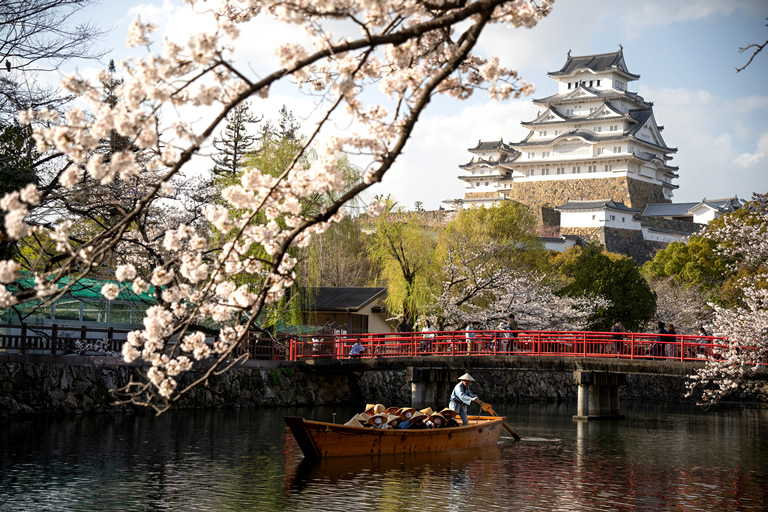
Springtime Himeji Castle with Blooming Cherry Blossoms
Within Hyogo Prefecture, the Harima area has a particularly high concentration of castles to see.
It is home to many castles, including Himeji Castle, which was the first in Japan to be registered as a UNESCO World Heritage Site, as well as Ako Castle and Tatsuno Castle, both of which are nationally designated historic sites.
Although they are all simply called castles, they differ depending on whether they are built in the mountains, near the sea, or on flat land; the state of affairs at the time when the castle was built, and how the castle owner thought and lived also influenced the design of the castle. It's also fun to look around and compare castles as defense bases, thinking things like, "If I were the lord, how would I prevent an enemy invasion?'' or "How would I invade this castle?''
Take A Stroll Around A Town That Samurai Once Walked
After touring the castle, take a stroll through the castle town where samurai once roamed.
Back then when a castle was built, houses were built around the castle for the samurai to live in, further creating an area that drew merchants and craftsmen. Those were castle towns. The castle lord built roads to attract the flow of people and goods, and encouraged merchants to engage in lively economic activities. These castle towns are often the basis of modern Japan's major cities.
For example, Himeji City, which was the castle town of Himeji Castle, is still the center of the Harima area. It also flourishes as a commercial area, and you can enjoy browsing the lively shopping district. In addition, Tatsuno City, the castle town of Tatsuno Castle, still retains strong vestiges of the castle town, such as samurai residences and white-walled storehouses. It is also now called "Harima's Little Kyoto."
In this way, there are many places in the Harima area where you can feel reminders of the period when samurai and townspeople lived vividly.
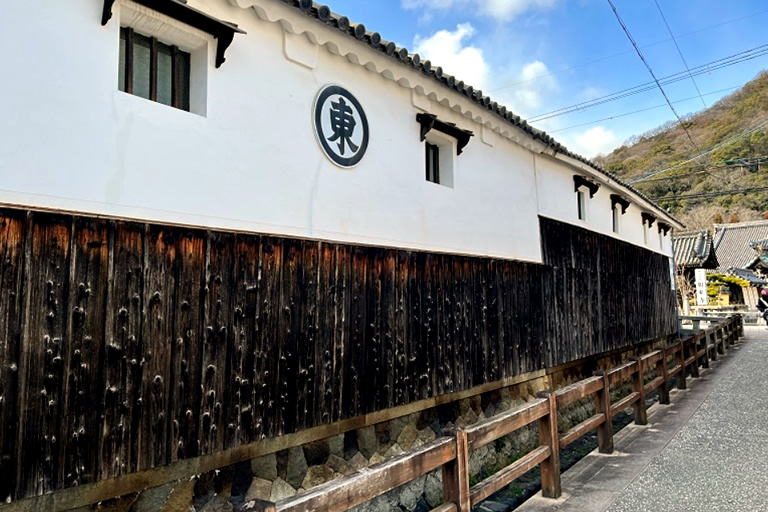
Tatsuno's Castle Town
Himeji Castle And Samurai Residences
If you want to begin a tour of Hyogo's castles, you should start with Himeji Castle.
After getting off JR Himeji Station, head to the observation deck at the North Exit, commonly known as Castle View. As the name suggests, you will be able to see Himeji Castle on the other side of Otemae Street, which stretches straight out from the station, so be sure to stop by. After walking for about 20 minutes through the lively Miyuki-dori Shopping District, you will arrive at Himeji Castle.
The beauty of the white walls against the blue sky is nearly dazzling, and when you see it in person up close, you'll understand why it is hailed as Japan's most famous castle. From the fact that it looks like a white heron gracefully spreading its wings, it is also called by the aliases Shirasagi Castle and Hakuro Castle (Hakuro is another reading of the kanji for Shirasagi, "white heron"). In 1993, it was designated as Japan's first UNESCO World Heritage Site as an outstanding wooden building unparalleled by any other in the world.
Himeji Castle was first built in 1346, and has been expanded by successive castle lords since then, taking its current form in 1618. Since then, it has not encountered any wartime destruction, and it can still be seen in that state even now, 400 years later, without any major damage from the World War II air raids. For this reason, Himeji Castle is also called "the unburning castle without war,'' and many people see it as a symbol of peace.
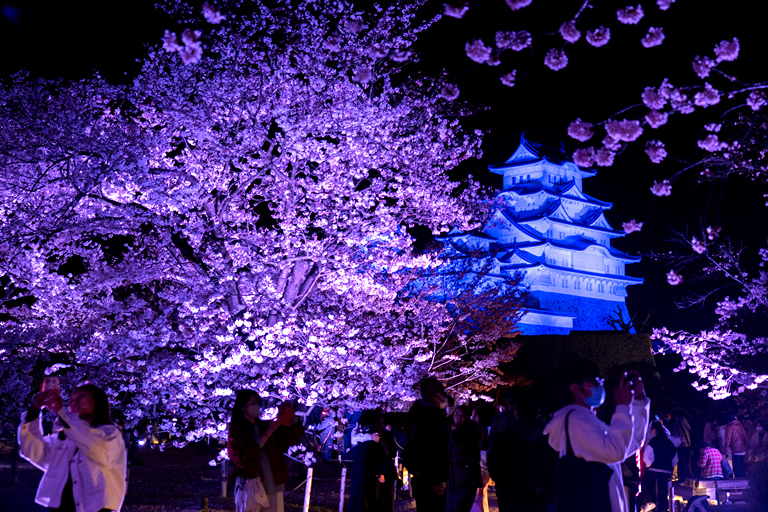
Himeji Castle is also a must-see at night. Illuminated Himeji Castle is a bewitching beauty.
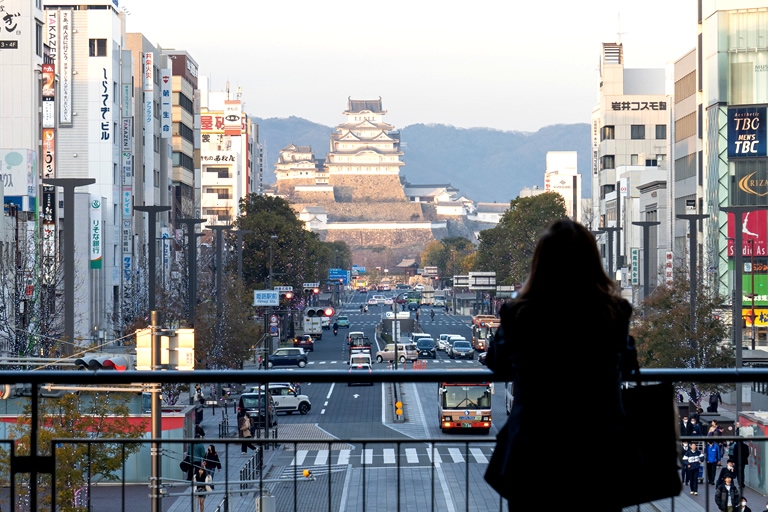
The outlook from Castle View.
Unfortunately, much of Himeji Castle's castle town was destroyed by air raids during the Pacific War. However, with the aim of preserving and utilizing cultural assets, Himeji City is making use of the remains of samurai residences, where samurai once lived, as the Himeji Castle Nishi-Oyashiki-Ato Garden Kokoen which was built right next to Himeji Castle. There are nine gardens on a site of approximately 33,000 square meters, and you can even see the castle tower of Himeji Castle from the gardens. You will be able to feel a different sort of Japanese beauty and tranquility than from within the castle.
There is also a restaurant attached, so after you've finished touring Himeji Castle, you can enjoy dishes using Himeji's specialty conger eel while looking out at the beautiful garden.
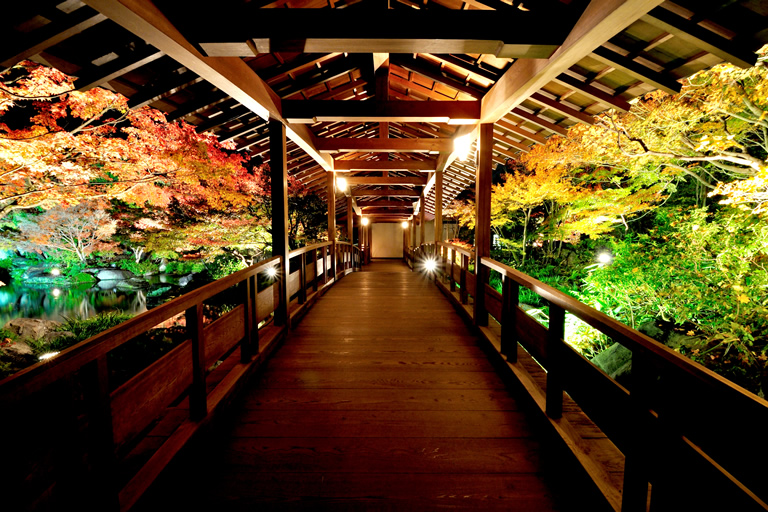
The maple leaves are beautiful in autumn in the garden.
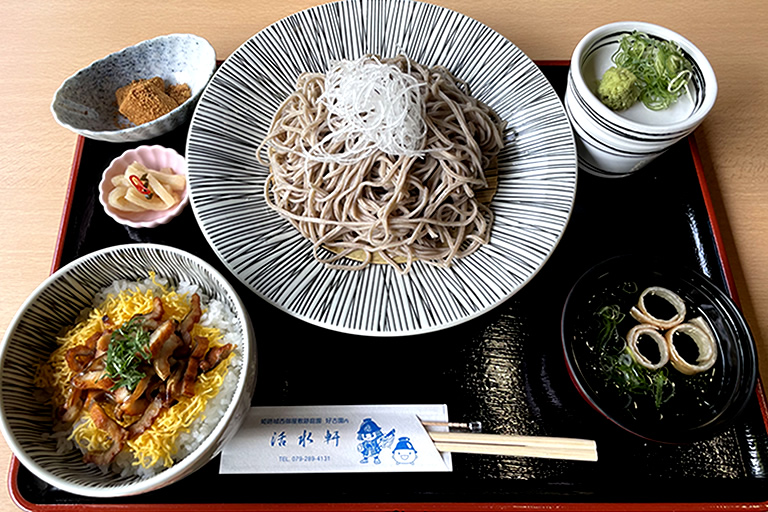
The Cold Soba and Conger Eel Rice Bowl Set, where you can also enjoy the famous conger eel.
You Can Also Make Soy Sauce in Little Kyoto, Tatsuno
The next day, head to Tatsuno Castle to feel more of the atmosphere of a former castle town. You will arrive at the closest station, Hontatsuno Station, about 20 minutes from Himeji Station by train. By car, it's also only about 30 minutes from Himeji City.
Many historic buildings besides Tatsuno Castle remain here, which is known as Harima's Little Kyoto. Gazing at the townscape of good old-fashioned Japan, you'll feel like you've traveled back in time.
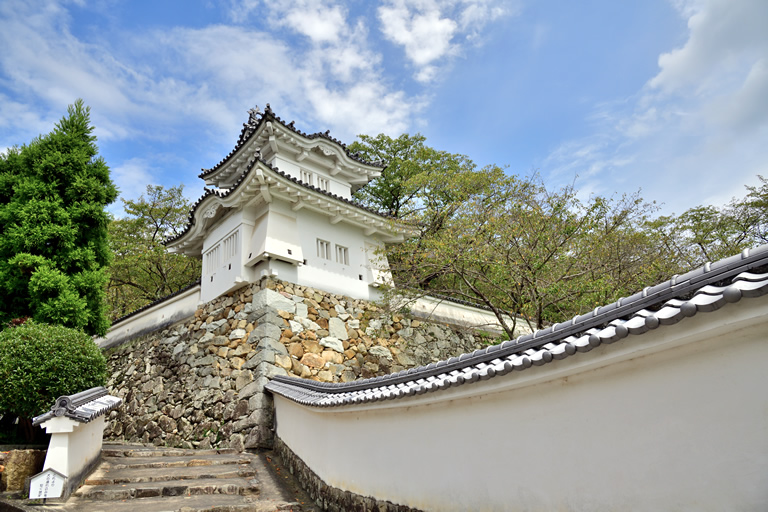
Tatsuno Castle, built about 500 years ago.
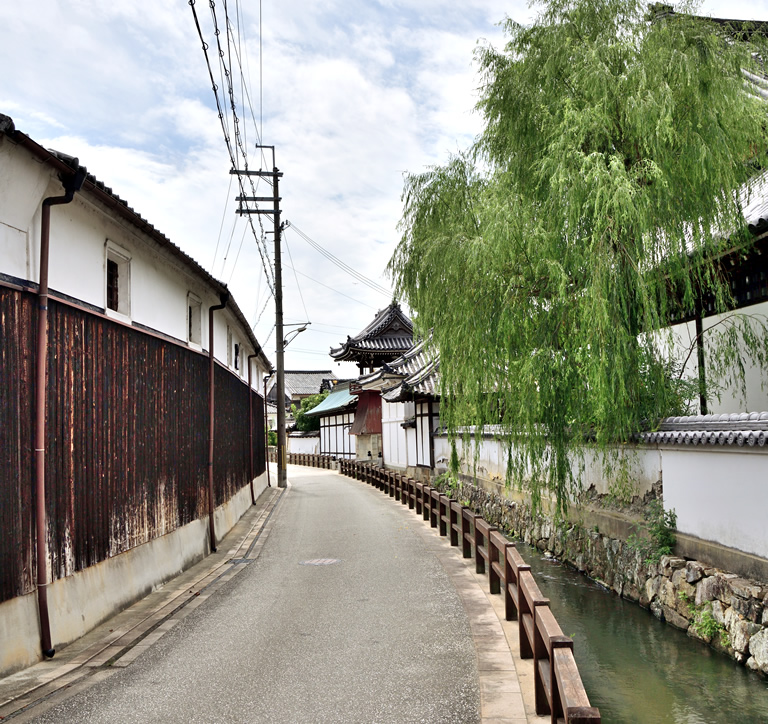
A townscape where it feels like a samurai might appear across the street any moment.
Tatsuno is also known as a production area for soy sauce. It is particularly famous for "usukuchi" soy sauce, which is light in color. The soy sauce we normally use is "koikuchi" soy sauce, which has a dark color, rich flavor, and strong aroma. The one, usukuchi soy sauce, has a mild aroma and a lighter color that does not ruin the color of the food. It is said to be the perfect seasoning to bring out the flavor and color of ingredients in Japanese cuisine which uses dashi. This usukuchi soy sauce was born in Tatsuno.
Tatsuno actually used to be a sake production area. However, around 1660, it is said that usukuchi soy sauce was created when amazake, which had not yet been made into sake, was added to soy sauce mash (a soft solid created by fermenting multiple ingredients during the soy sauce brewing process). Even now, Tatsuno boasts the highest production volume of usukuchi soy sauce in Japan.
You can make your own soy sauce at Hakko LabCoo in the city. The "hakko'' in the store's name refers to fermentation, in which microorganisms decompose ingredients thereby increasing their taste and nutritional value. Yogurt and cheese are well-known to be made by this process, but in fact many seasonings used in Japanese cuisine are fermented products, such as soy sauce, miso, sake, etc. We hope that by making soy sauce, you will come in touch with Japan's fermentation culture.
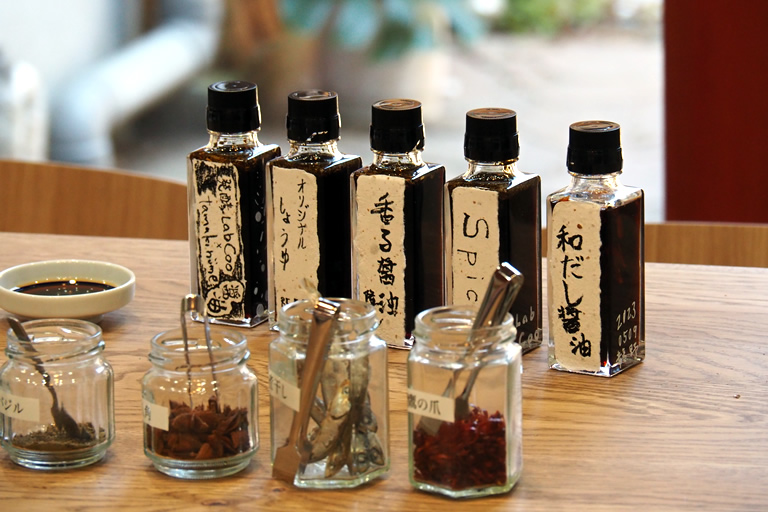
Soy sauce making experience at Hakko LabCoo.
Salt-Making Experience & Hot Springs in Ako, Salt Town
After a soy-sauce making experience at Tatsuno, why not take the next day to visit Ako Castle, a nationally designated historic site?
Ako is in fact connected to the flourishing of Tatsuno's soy sauce production. High-quality salt is essential for making soy sauce, and this was Ako salt from Ako Castle. Ako was the first place in Japan to establish the technology to produce salt from seawater in large quantities; it is said that through production and sale of this salt, they gained ample financial power and developed the town around Ako Castle. Although salt production methods have changed over time, Ako still produces about 20% of the salt in Japan.
About 30 minutes by car from Tatsuno City, or about an hour by public transportation by bus and train. Enjoy the mini-trip while looking out the train window.
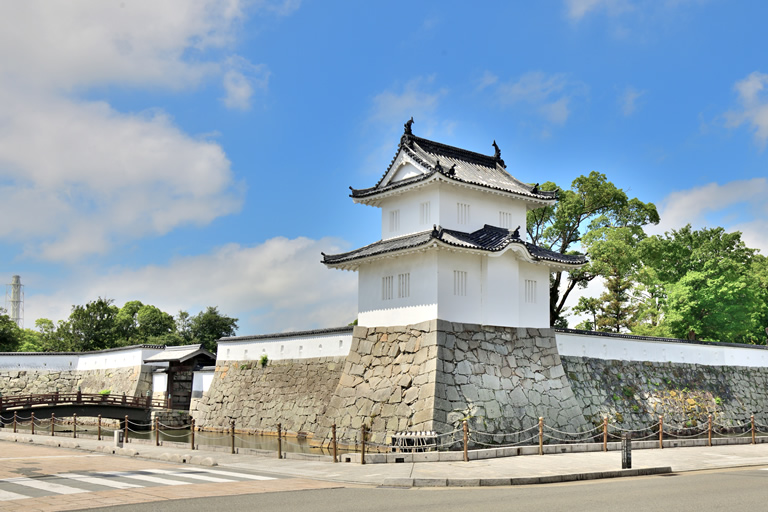
Ako Castle was built over a period of 13 years.
Ako City also has a place where you can try your hand at making salt, and that is AMAMI TERRACE by the sea. At the cafe and workshop on the Iwatsuhime Shrine grounds, you can enjoy lunch or sweets made with salt while looking out at the sea, and even try your hand at making salt.
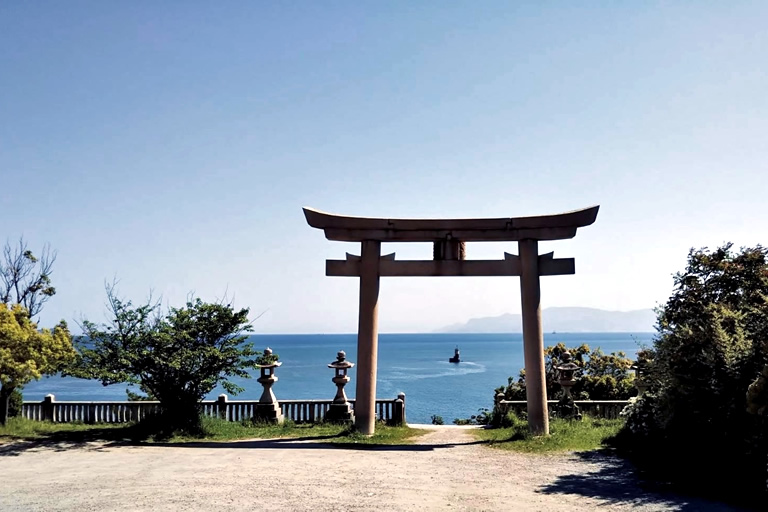
Iwatsuhime Shrine is a rare shrine that faces the sea.

Experience salt-making by heating brine in which the salt concentration of seawater has been increased.
We recommend staying at Ako Onsen during your Harima trip. In an onsen facing the Seto Inland Sea, you can relax and enjoy the hot spring while listening to the sound of the waves and watching the sunset. The spring quality is rich in salt and minerals, and is highly effective at heating up the body, so it is also known as the "reviving hot spring.''
The hot spring water at Ako Onsen is sure to heal any fatigue from this trip.
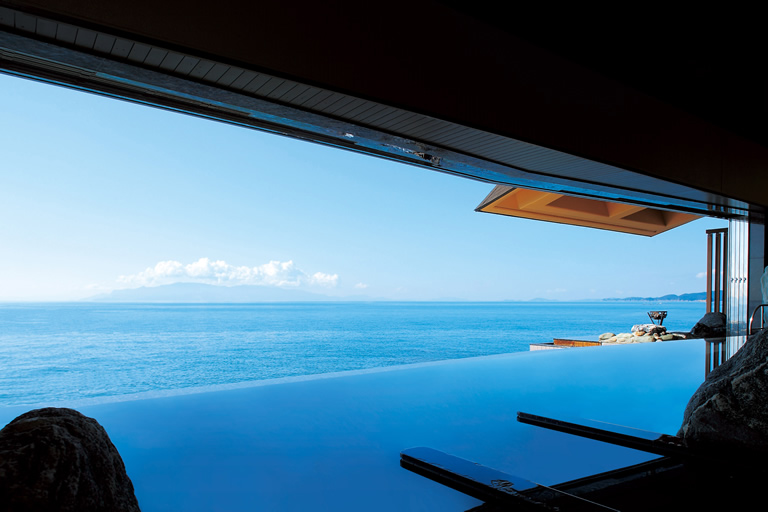
Ako Onsen's Ginpaso, where you can enjoy a bath that feels like it's a part of the ocean.
●Himeji Castle
https://www.hyogo-tourism.jp.e.atl.hp.transer.com/spot/0651
●Hyogo Field Pavilion: E-Bike Cycling Tour Himeji Castle Town Tour Along the Old Highway
https://expo2025-hyogo-fieldpavilion.jp.e.atd.hp.transer.com/program/40
●Himeji Castle Nishi-Oyashiki-Ato Garden Kokoen
https://www.hyogo-tourism.jp.e.atl.hp.transer.com/spot/0625
●Tatsuno Castle
https://www.hyogo-tourism.jp.e.atl.hp.transer.com/spot/330
●Hyogo Field Pavilion: Brewing Experience and Brewery Tour in Tatsuno
https://expo2025-hyogo-fieldpavilion.jp.e.atd.hp.transer.com/program/26
●Ako Castle
https://www.hyogo-tourism.jp.e.atl.hp.transer.com/spot/552
●Hyogo Field Pavilion: Salt-Making Workshop at Ako, Salt Town (with Lunch)
https://expo2025-hyogo-fieldpavilion.jp.e.atd.hp.transer.com/program/72
●Japan Heritage: Banshu Ako, the Town That Produced Japan's No. 1 Salt
https://www.hyogo-tourism.jp.e.atl.hp.transer.com/feature/jheritage/06/
●Ako Onsen
https://www.hyogo-tourism.jp.e.atl.hp.transer.com/spot/543
Date : 2024.03.18



